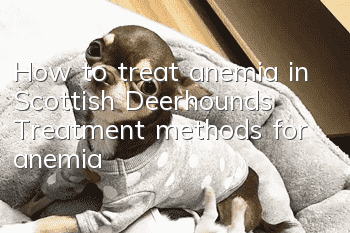How to treat anemia in Scottish Deerhounds? Treatment methods for anemia

How to treat anemia in Scottish Deerhounds? Many novice poop owners don’t know that dogs can also be anemic. So what are the symptoms of anemia in dogs? And how to treat anemia?
1 Hemorrhagic anemia
Cause: Acute hemorrhagic anemia, due to trauma or surgery, rupture of internal organs (such as liver, spleen, vena artery and vena cava, etc.) and external blood vessels causes massive bleeding, resulting in a sudden decrease in the body's hemolytic capacity.
Chronic hemorrhagic anemia is mainly caused by chronic inflammation of the stomach and intestines, hemorrhagic inflammation of the lungs, kidneys, bladder, and uterus, resulting in long-term repeated bleeding. In addition, canine hookworm infection can also cause chronic hemorrhagic anemia.
Symptoms: Common symptoms include visible mucous membranes, pale skin, rapid heartbeat, and general muscle weakness. Symptoms are proportional to the amount of bleeding. Excessive bleeding may cause collapse, restlessness, decreased blood pressure, coldness in the limbs, ears and nose, unsteady gait, and muscle tremors. In the later stage, drowsiness, coma, and shock may be seen.
For dogs with small amounts of bleeding and chronic bleeding, the initial symptoms are not obvious. However, the sick dog can gradually lose weight, and the visible mucous membrane gradually develops from light red to white. It is listless, has general weakness, lethargy, is inactive, has a fast and weak pulse, and shallow breathing. Slight edema of the lower jaw and limbs is often seen. Severe cases can lead to shock, heart failure and death.
Diagnosis: The diagnosis can be confirmed based on clinical symptoms, red blood cell count and hematocrit examination.
Treatment: Stop bleeding and restore hemolysis.
① Traumatic bleeding can be stopped by ligation, compression, or tourniquet. For bleeding at the end of the limbs, owners can use a tourniquet to stop the bleeding and immediately send them to a veterinary hospital for treatment.
② Injection of hemostatic drugs: hemostasis 25 mg/kg body weight; vitamin K 30.4 mg/kg body weight; vitamin K 11 mg/kg body weight; coagulopathy 1.5 mg/kg body weight.
③ To replenish hemolytic capacity, dextran, glucose, compound saline, and amino acid preparations can be infused intravenously. Veterinary hospitals with conditions should provide blood transfusion therapy.
2 Hemolytic anemia
Hemolytic anemia
Anemia caused by massive destruction of red blood cells due to various reasons is called hemolytic anemia.
Cause:
① Caused by infectious factors. Such as leptospirosis, herpes pathogens, trypanosomiasis, hemolytic streptococcus infection, etc.
② Toxic diseases. Heavy metal poisoning such as: lead, copper, arsenic, mercury, etc.; chemical drug poisoning: benzene, phenol, sulfonamide, etc. Hemolytic anemia can also be caused by police dogs inhaling TNT explosives while performing tasks.
Antigen-antibody reaction. Hemolytic anemia in newborn dogs. Because the blood type of the newborn puppies is different from that of the mother dog, an antigen-antibody reaction occurs after eating breast milk, resulting in hemolytic anemia in the puppies.Blood. Transfusion of heterotypic blood types can also cause hemolysis.
Other factors, such as febrile disease, lymphosarcoma, myeloid leukemia, plasma hemoglobinemia, red blood cell pyruvate kinase deficiency and other factors can cause hemolytic anemia.
Symptoms: The main symptoms are visible yellowing of the mucous membranes, yellowing of the corners of the skin and mouth, depression, motor weakness, and weight loss. In the later stage, the visible mucous membranes may be white and yellow, lethargic, hemoglobinuria, and body weight loss.
Treatment: Expand hemolytic volume, remove the cause, and treat symptoms.
Fluid rehydration and blood transfusion therapy. For toxic diseases, antidotes are given; for parasitic infections, insecticides are given for treatment. Also combined with hormonal therapy, such as cortisone, prednisone, and dexamethasone.
3 Nutritional anemia
Nutritional anemia
Nutritional anemia refers to anemia caused by the lack of certain hematopoietic substances, which affects the production of red blood cells and hemoglobin.
Cause: Mainly caused by lack of protein, iron, copper, cobalt and vitamins.
①Protein deficiency: caused by insufficient protein intake by animals or chronic digestive dysfunction.
② Trace element deficiency: iron, copper, and cobalt deficiency. Clinically, iron deficiency anemia is common. Iron is an essential component for hemoglobin synthesis; copper deficiency can also lead to reduced hemoglobin synthesis.
③ Vitamin deficiency: Deficiency of vitamin B1, vitamin B12, vitamin B6, folic acid, niacin, etc. can lead to disorders in the production of red blood cells and hemoglobin synthesis, resulting in nutritional anemia.
Most of the above factors are caused by the dog's single food, chronic digestive tract diseases and intestinal parasitic diseases, which cause intestinal absorption dysfunction, leading to nutritional anemia over time.
Symptoms: Nutritional anemia develops slowly and mainly manifests as progressive weight loss and malnutrition. Weakness and weakness, abdominal curling, rough coat, pale mucous membranes, high weakness in later movements, shaking, difficulty in standing up after falling to the ground, until lying on the ground and complete body failure.
Treatment: Strengthen feeding, supplement hematopoietic substances, and provide protein-rich and vitamin-rich foods.
Ferrous sulfate 50 mg/kg body weight, taken orally 2-3 times/day. Cobalt chloride 0.3% solution, 3-5 ml/day orally.
Vitamin B15-10 mg/kg body weight, vitamin B125-10 ml/kg body weight, mixed intramuscular injection, 1 time/day. Folic acid 1-3 mg/kg body weight, taken orally, once a day.
In addition, glucose and various amino acid preparations can be supplemented to help restore body functions.
4Aplastic anemia
Aplastic anemia
Aplastic anemia refers to bone marrowAnemia caused by disorders of hematopoietic function.
Cause:
① Poisoning. Certain heavy metals, such as gold, arsenic, bismuth, etc.; certain organic compounds, such as benzene, phenol, trichlorethylene, etc.; certain excessive therapeutic drugs, such as chloramphenicol, sulfa drugs. Both can cause aplastic anemia.
②Radiation damage. Exposure to large amounts of X-rays and certain radioactive elements. It can be damaged by bone marrow cells, red blood cells, osteoid cells and megakaryocytes, causing these cells to suffer irreversible damage, leading to loss of hematopoietic function.
③Certain diseases. For example: chronic kidney disease, leukemia, hematopoietic organ tumors, etc., can all lead to aplastic anemia.
Symptoms: The clinical symptoms of aplastic anemia develop relatively slowly. In addition to the above three anemia symptoms, they are mainly manifested in changes in the blood image, low levels of red blood cells, white blood cells, and hemoglobin, and the disappearance of reticulocytes in the blood.
Treatment: Improve hematopoietic function and replenish blood volume.
① Blood transfusion therapy. Blood transfusion is performed after a blood matching test, and the blood transfusion rate should be slow, usually 10-15 ml/kg of body weight per hour. The amount of blood transfusion can be given according to the specific volume of the sick dog.
② Anabolic hormone therapy. For example: Testosterone (can stimulate red blood cell production) 1-2 mg/kg body weight, intramuscular injection, 1-3 times a week; Stanozolol 0.4-0.6 mg/kg body weight, taken orally once every 2-3 days.
- Introduction to the best training time for Cavalier King Charles Spaniel
- How to care for Lakeland Terrier Lakeland Terrier care knowledge
- How to train Lakeland Terrier to listen to commands How to train Lakeland Terrier to listen to commands
- What to do if your Sipaj has a fever What to do if your Sipaj has a fever
- What should I do if my Lakeside Terrier suffers from skin diseases? Treatment methods for Lakeside Terrier skin diseases
- The Difference Between Poodle and Teddy
- An introduction to what Cavalier King Charles Spaniels should not eat
- Is the Australian Cattle Dog easy to raise? How to raise the Australian Cattle Dog?
- How to train a Cavalier King Charles Spaniel Detailed explanation of how to train a Cavalier King Charles Spaniel
- Solutions for Cavalier King Charles Spaniel Diarrhea



